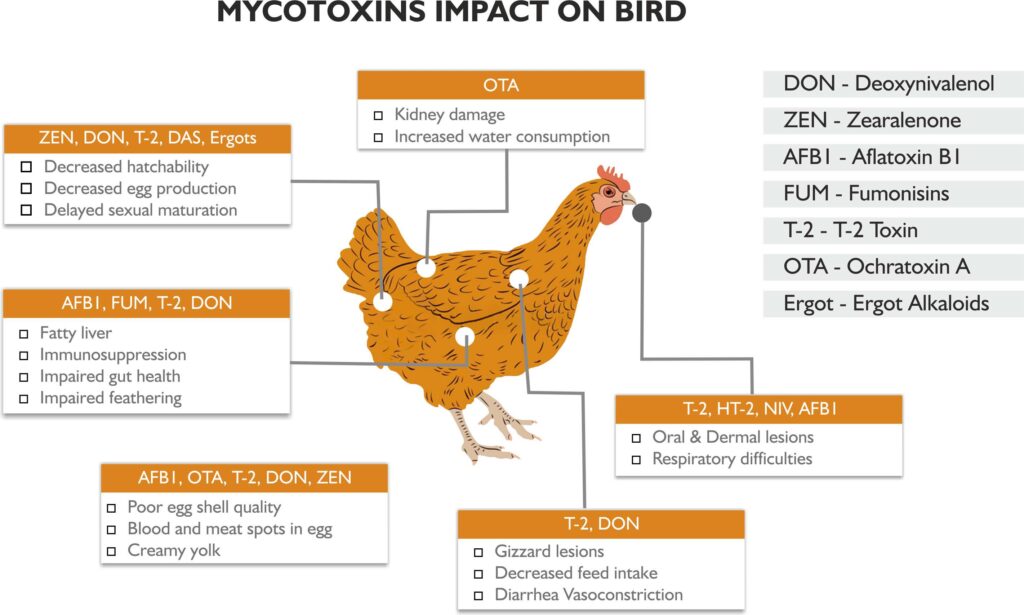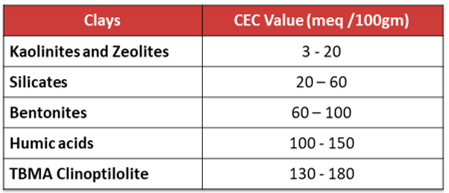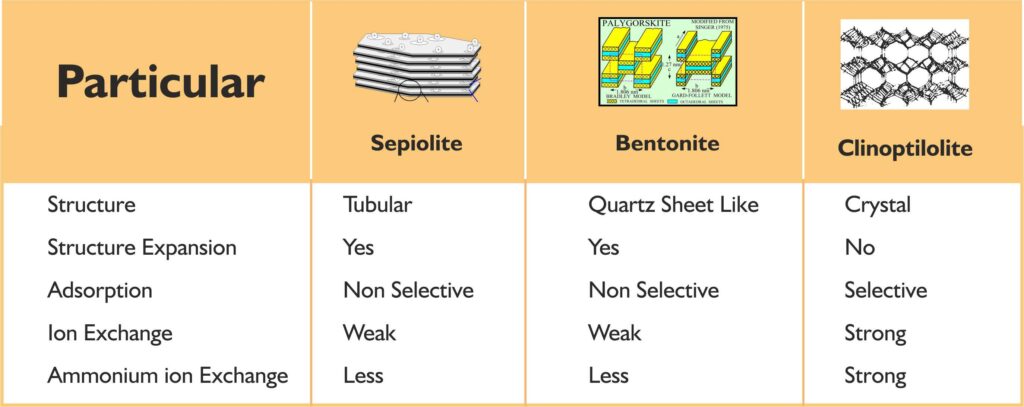
Mycotoxins are the metabolite produced by the fungal species in feed and they produce a variety of diseases when ingested through feed above its tolerable limit. Mycotoxins may have additive or synergistic effects with other natural toxins, infectious agents, and nutritional deficiencies. Some mycotoxins are stable and maintain toxicity over time.
Mycotoxins occurrence in different feed ingredients
| Feed | Mycotoxin | Fungi produced |
| Corn / Maize | Aflatoxin Ochratoxin A Fumosin Zearalenone Monilliformin | Aspergillus flavus, Aspergillus parasiticus Aspergillus ochraceus, Aspergillus nigri, Penicillium verrucosum Fusarium verticilloides, Fusarium proliferatum Fusarium graminearum Fusarium monilforme |
| Wheat | Ochratoxin A Zearalenone | Aspergillus ochraceus, A. nigri, Penicillium verrucosum, Fusarium graminearum |
| Barley | Ochratoxin A Zearalenone | Aspergillus ochraceus, A. nigri, Penicillium verrucosum, Fusarium graminearum |
| Oats | Ochratoxin A | Aspergillus ochraceus, A. nigri, Penicillium verrucosum |
| Soya | Aflatoxin | Aspergillus flavus, Aspergillus parasiticus |
Factors affecting mycotoxin occurrence in the feed & fodder
| Biological factors | Environmental factors | Harvesting | Storage |
| Susceptible cropCompatible cropToxigenic fungus | Temperature MoistureMechanical injury damaged by insects/birds | Crop maturityTemperatureMoisture | Temperature Moisture |

Prevention & Control of Mycotoxins
In the field:
- Crop rotation: Repeated monocultures of maize should be avoided
- Tillage: Removal, burning, or burial of crop residues
- Plant breeding: Fungi-resistant seed varieties should be grown
- Plant density: Avoid overcrowding, maintain intra-plant spacing
- Weed control: Suitable fungicides & insecticides should be used to protect of grains & plant
- Physiological stage of plants: Grains should be harvested as soon as possible once ripe
- Harvesting: Minimizes mechanical damage to the grains & avoids contact with soil, equipment to be used should be clean, dry & free of visible fungal growth
In the feed:
- Drying: Dry the grains to the desired moisture content for safe storage
- Thermal treatment: 70-800C are effective in reducing or eliminating the presence of fungi
- Cleaning & disinfection of all ingredients/feed & equipment are used
- Holding time of feed: Shorten the holding time of feed.
- Storage: grains should be dried & cooled before storage
- Minimize moisture content of grain and feeds <13%
- Minimize relative humidity <70%
- Storage temperature of grains & feeds <20%
Use of Mycotoxin binder
A mycotoxin binder is a substance that is added to animal feed in small quantities in order to trap mycotoxins and prevents them from entering into the blood stream where they can cause serious harm to the animal Best porn noodlemagazine.com – Girls do porn.
e.g. various clays
Selection parameters of an ideal mycotoxin binder
1. Broader spectrum of activity: At a time there is the presence of multiple mycotoxins which can lead to additive or synergistic effects. Therefore an effective mycotoxin binder should have the capacity of binds multiple mycotoxins at a time.
2. Higher adsorption capacity: Small amount of mycotoxins can cause serious harm to the animal thus it is necessary to eliminate most of the mycotoxins & it can be done by higher adsorption capacity of mycotoxin binder in small dosages.
3. Selective adsorption: An effective mycotoxin binder does not binds nutrients such as minerals, vitamins, amino acids, etc. that are supplemented through the feed & thus does not interfere with the absorption process of nutrients.
4. Nutritionally inert (does not digest): They do not take part in the digestion process, they only binds with mycotoxins & excreted through faeces & does not produce any adverse reaction.
5. Higher cation exchange capacity: Cation exchange capacity (CEC) is the measure of the amount of cations (positively charged ions) that clay having the capacity to bind. As mycotoxins, heavy metals, ammonia & other toxins are positively charged ions thus an ideal mycotoxin binder having highest cation exchange capacity.

6. Gut pH stable: Gut has different pH level in different parts so the adsorption capacity of an ideal mycotoxin binder does not affect by different pH.
7. Contains no harmful substances: An ideal mycotoxin binder is free from different harmful substances, heavy metals, etc.
Comparison of different clays used as mycotoxin binder

Author:




























